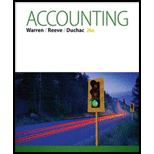
Statement of
Indirect method: Under this method, the following amounts are to be adjusted from the Net Income to calculate the net cash provided from operating activities.
Cash flows from operating activities: These are the cash produced by the normal business operations.
The below table shows the way of calculation of cash flows from operating activities:
| Cash flows from operating activities (Indirect method) |
| Add: Decrease in current assets |
| Increase in current liability |
| |
| Loss on sale of plant assets |
| Deduct: Increase in current assets |
| Decrease in current liabilities |
| Gain on sale of plant assets |
| Net cash provided from or used by operating activities |
Table (1)
Cash flows from investing activities: Cash provided by or used in investing activities is a section of statement of cash flows. It includes the purchase or sale of equipment or land, or marketable securities, which is used for business operations.
The below table shows the way of calculation of cash flows from investing activities:
| Cash flows from investing activities |
| Add: Proceeds from sale of fixed assets |
| Sale of marketable securities / investments |
| Interest received |
| Dividend received |
| Deduct: Purchase of fixed assets/long-lived assets |
| Purchase of marketable securities |
| Net cash provided from or used by investing activities |
Table (2)
Cash flows from financing activities: Cash provided by or used in financing activities is a section of statement of cash flows. It includes raising cash from long-term debt or payment of long-term debt, which is used for business operations.
The below table shows the way of calculation of cash flows from financing activities:
| Cash flows from financing activities |
| Add: Issuance of common stock |
| Proceeds from borrowings |
| Proceeds from issuance of debt |
| Issuance of bonds payable |
| Deduct: Payment of dividend |
| Repayment of debt |
| Interest paid |
| Redemption of debt |
| Repurchase of stock |
| Net cash provided from or used by financing activities |
Table (3)
To Prepare: A statement of cash flows using the indirect method for presenting cash flows from operating activities.
Answer to Problem 16.1BPR
| M Equipment Company | ||
| Statement of Cash Flows - Indirect Method | ||
| For the Year Ended December 31, 2016 | ||
| Details | Amount ($) | Amount ($) |
| Cash flows from operating activities: | ||
| Net income | 141,680 | |
| Adjustments to reconcile net income to net cash flow from operating activities: | ||
| Depreciation expense | 14,790 | |
| Loss on sale of investments | 10,200 | |
| Changes in current operating assets and liabilities: | ||
| Increase in |
(19,040) | |
| Increase in inventory | (8,670) | |
| Increase in accounts payable | 11,560 | |
| Increase in accrued expense payable | 3,740 | (12,580) |
| Net cash provided by operating activities | $154,260 | |
| Cash flows from investing activities: | ||
| Cash received from sale of investment | 91,800 | |
| Cash used for purchase of land | (295,800) | |
| Cash used for purchase of equipment | (80,580) | |
| Net cash used for investing activities | ($284,580) | |
| Cash flows from financing activities: | ||
| Cash received from sale of common stock | 250,000 | |
| Cash used for dividends | (96,900) | |
| Net cash provided by financing activities | $153,100 | |
| Increase (decrease) in cash | $22,780 | |
| Cash at the beginning of the year | 47,940 | |
| Cash at the end of the year | $70,720 | |
Table (4)
Explanation of Solution
Working notes:
Prepare the schedule in the changes of current assets and liabilities.
| Schedule in the Change of Current Assets and Liabilities | ||||
| Details | Amount ($) | Effect on Operating Activities | ||
| Beginning Balance | Ending Balance | Increase/ (Decrease) | ||
| Accounts receivable | 188,190 | 207,230 | 19,040 | Deduct |
| Inventories | 289,850 | 298,520 | 8,670 | Deduct |
| Accounts payable | 194,1400 | 205,700 | 11,560 | Add |
| Accrued expenses payable | 26,860 | 30,600 | 3,740 | Add |
Table (5)
Calculate the amount of depreciation expense:
Calculate the amount of loss on sale of investments:
Calculate the amount of dividends:
Therefore, the ending cash balance is $70,720.
Want to see more full solutions like this?
Chapter 16 Solutions
Accounting (Text Only)
- Not Ai Solutionarrow_forwardHi expert please give me answer general accounting questionarrow_forwardXYZ Technologies, Inc., purchased advanced robotics equipment three years ago for $20 million. The machinery can be sold in the current market for $18.5 million. XYZ's current balance sheet shows net fixed assets of $16 million, current liabilities of $750,000, and net working capital of $300,000. If all current assets were liquidated today, the company would receive $1.25 million in cash. a. What is the book value of XYZ's total assets today? b. What is the market value of XYZ's total assets today?arrow_forward
 Financial AccountingAccountingISBN:9781305088436Author:Carl Warren, Jim Reeve, Jonathan DuchacPublisher:Cengage Learning
Financial AccountingAccountingISBN:9781305088436Author:Carl Warren, Jim Reeve, Jonathan DuchacPublisher:Cengage Learning College Accounting (Book Only): A Career ApproachAccountingISBN:9781337280570Author:Scott, Cathy J.Publisher:South-Western College Pub
College Accounting (Book Only): A Career ApproachAccountingISBN:9781337280570Author:Scott, Cathy J.Publisher:South-Western College Pub Financial Accounting: The Impact on Decision Make...AccountingISBN:9781305654174Author:Gary A. Porter, Curtis L. NortonPublisher:Cengage Learning
Financial Accounting: The Impact on Decision Make...AccountingISBN:9781305654174Author:Gary A. Porter, Curtis L. NortonPublisher:Cengage Learning EBK CONTEMPORARY FINANCIAL MANAGEMENTFinanceISBN:9781337514835Author:MOYERPublisher:CENGAGE LEARNING - CONSIGNMENT
EBK CONTEMPORARY FINANCIAL MANAGEMENTFinanceISBN:9781337514835Author:MOYERPublisher:CENGAGE LEARNING - CONSIGNMENT Managerial AccountingAccountingISBN:9781337912020Author:Carl Warren, Ph.d. Cma William B. TaylerPublisher:South-Western College Pub
Managerial AccountingAccountingISBN:9781337912020Author:Carl Warren, Ph.d. Cma William B. TaylerPublisher:South-Western College Pub





